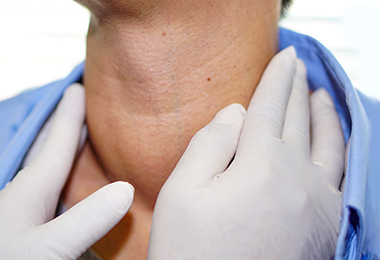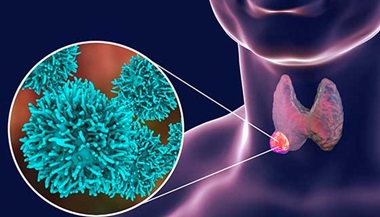Thyroid Cancer: What Women Should Know
Featured Expert:
The symptoms start slowly. Fatigue is the most common. There might be changes in hair, nails or skin, and other vague complaints that could be caused by aging, diet, stress or dozens of other factors.
Women in the prime of their lives, busy with work and families, may not even notice. When a doctor finally diagnoses an underactive thyroid due to cancer, it often comes as a shock.
Leila J. Mady, M.D., Ph.D, M.P.H., assistant professor of Otolaryngology–Head and Neck Surgery at The Johns Hopkins Hospital, says: “Typical thyroid cancer patients are women between the ages of 30 and 60 — with the highest risk in the reproductive years. That said, thyroid cancer can occur at any age, including in children and older adults, but it's less common in these age groups.”

Thyroid Cancer: Common in Women
Thyroid disorders are more common in women, probably due to the roles of hormones, which are different in females than in males.
Thyroid nodules (growths), Mady says, affect up to 80 percent of women, but only 5 percent to 15 percent of those lumps and bumps are cancerous. Better diagnostic testing with ultrasound imaging and fine-needle aspiration biopsy means detecting thyroid tumors is on the rise. Overall, this has led to the rising incidence of thyroid cancer, which is now the third most common cancer worldwide.
“Malignant” and “cancer” are scary words, but Mady says that most thyroid cancer is very treatable, even when the cancer cells spread to nearby lymph nodes, which occurs frequently.
“With thyroid cancer we talk about prognosis in terms of 20-year survival instead of five years, as we do with most other cancers. It’s usually a slow-moving disease. There’s a 98 to 99 percent survival rate at 20 years,” she says.
“We treat it almost like a chronic condition where the patient gets treatment and visits her doctor regularly for follow-up.”
Diagnosing Thyroid Cancer
If a woman notices a lump in the base of her neck, or if a doctor notices a lesion on the thyroid during imaging studies performed for unrelated reasons, the next diagnostic test is usually lab work, followed by an ultrasound, which Mady says provides a lot of information on the nodule.
The management of thyroid nodules depends on various factors, including the size of the nodule, its characteristics (such as appearance on imaging studies), presence of symptoms and risk factors. It is very much an individualized approach based on close collaboration between patients and their treatment team.
Doctors may recommend watchful observation of small nodules. Larger growths may be tested with fine-needle aspiration, in which the doctor collects a sample of cells from the nodule with a needle and looks at them under a microscope.
Mady says that about 70 percent of nodule biopsies will show that the nodule is benign. Another 25 percent of biopsies are inconclusive, and the remaining 5 percent show that cancer is present.
Treatment for Thyroid Cancer
The most common treatment is surgery to remove the thyroid and any affected lymph nodes. Afterward, the patient will take thyroid hormones to cover the loss of the gland and radioactive iodine to treat any remaining cancer cells.
Traditional surgical removal of the thyroid gland, or thyroidectomy, leaves a prominent scar on the front of the neck. Mady notes that some thyroid cancer survivors are fine with their thyroidectomy scar and regard it as a badge of honor.
But plenty of patients don’t want the constant reminder of cancer surgery each time they look in the mirror. Or they don’t necessarily want a scar to be the first thing a stranger notices. Minimally invasive techniques, radiofrequency ablation (RFA) and ethanol ablation are alternative treatment options that can be considered in certain cases.
Working on Recovery
Even after successful surgery, recovery takes time, and some patients need weeks off of work. The body needs to adjust to the thyroid medication that’s replacing the hormone no longer provided by the now-absent thyroid.
Her advice to women is to find a doctor who listens. “Women who have had thyroid problems can feel frustrated. They know something is wrong, and want to be taken seriously. At the busiest time in their lives, they want to regain their health and their energy."
“They’re looking to us for solutions, and the science is catching up, with better diagnosis and options for treatment.”
Thyroid and Parathyroid Care

Our thyroid specialists, as part of the head and neck endocrine surgery team, diagnose and treat patients with a variety of thyroid and parathyroid conditions, including tumors, nodules and hyperparathyroidism.







